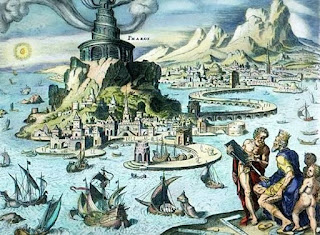 | A drawing of the lighthouse by German archaeologist Prof. H. Thiersch (1909), later used as an illustration in The House of Ptolemy by E. R. Bevan published by Methuen Publishing, London, 1927. Some of which is quoted below. High Resolution Image |
The lantern was formed of eight columns, surmounted by a cupola above which was raised a bronze statue (probably of Poseidon) about seven metres high. The flame was obtained by burning resinous wood. It is believed that convex mirrors made of metal were used to give a longer p96range to the light."31 This huge building has perished so utterly that we can now guess what it looked like only by incidental inscriptions in ancient books, by coins, and by the analogy of ancient remains in other places. Putting all the available material together, Professor Thiersch has made a conjectural restoration of it, which is reproduced on page 95.
The dedicatory inscription ran "Sostratus son Dexiphanes of Cnidos to the Saviour Gods on behalf of sea-farers." It is questionable who are meant by the "Saviour Gods" (Sotēres Theoi). That was the way in which Ptolemy I and Berenice were described officially after their deification, and one would naturally suppose that in a work of this kind, done by the king's order at Alexandria, Ptolemy I and Berenice were meant. On the other hand, "Saviour Gods" was also the way in which Castor and Pollux, the special gods of sailors, were regularly described, and it may be that the dedication was inscribed on the lighthouse before the official deification of Ptolemy I and Berenice. It may be again that there was an ambiguity which was intentional.
It is certainly remarkable that the architect was allowed by the king to dedicate a work of this kind in his own name. A story was afterwards invented to account for the dedication. Sostratus, it was said, had covered his own name (sunk, like the rest of the inscription, into the stone in huge letters of lead) with a thin layer of plaster, which looked like the stone, and had inscribed on this plaster the name of Ptolemy. He had counted on the plaster scaling off after his death." The House of Ptolemy by E. R. Bevan
 | A fanciful 16th century interpretation is depicted in this hand-coloured engraving of the Pharos by Martin Heemskerck. |
Technorati tags: Public Domain Clip Art and clip art or public domain and Seven Wonders of the World or Lighthouse of Alexandria and Maarten van Heemskerck or Carbon nanotubes endure heavy wear and tear or Seven Wonders of the World Colossus of Rhodes and Press Conference by the President Benchmark Assessment Report VIDEO PODCAST













No comments:
Post a Comment